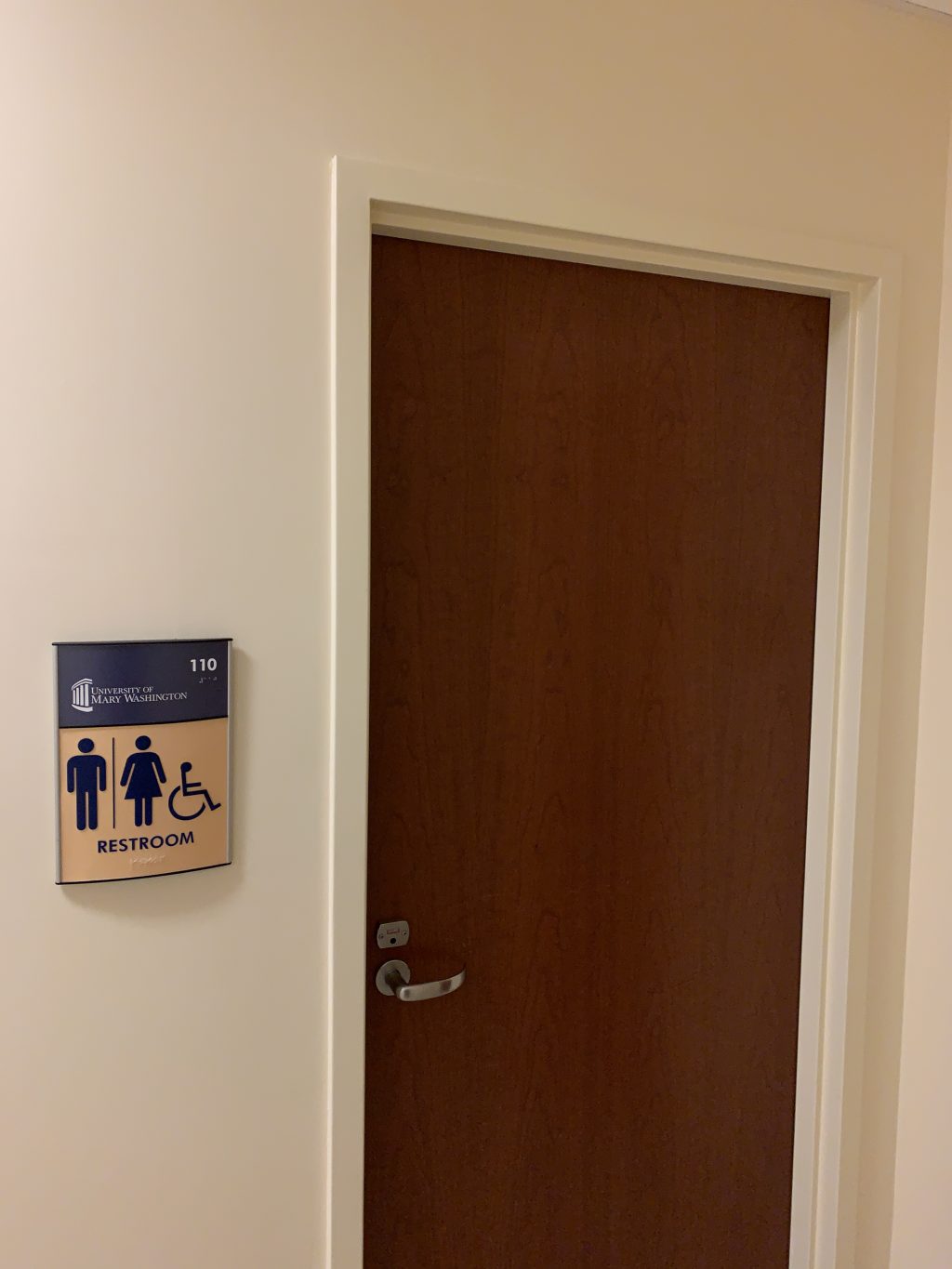Gender neutral bathrooms need greater presence on campus
4 min read
Gender neutral bathrooms change in each building to accommodate student needs. ( Alex Caldas | The Blue & Gray Press)
By QUINN BURGARD
Staff Writer
Gender-neutral bathrooms are becoming increasingly common in workplaces, retailers and colleges across the country. UMW does possess gender-inclusive bathrooms, but not in every building. In order to provide the utmost comfort and support for students, UMW should construct additional gender-neutral bathrooms and improve existing ones across campus.
Following UMW’s commitment to creating an all-inclusive environment, the campus provides 32 gender-inclusive bathrooms according to UMW’s Diversity and Inclusion website. Of these, 14 are in public buildings, with the rest located in residential buildings.
In buildings such as Combs and Monroe, there is a gender-inclusive public restroom, with multiple stalls to allow usage by anybody. In other buildings, such as Mason, Randolph, Woodard, and Ball, there are multiple single-stall coed bathrooms. Sabrina Johnson, vice president for Equity and Access, said that the designations of these bathrooms “may change for reasons that include recommendations from our students, faculty and staff and alterations to or changes in use of existing buildings.”
Single-stall gender-inclusive bathrooms can allow everybody, no matter how they identify, to feel comfortable. They alleviate the focus on which gendered bathroom someone chooses to use and provide more privacy. They allow students who may be uncomfortable sharing a bathroom with other people to have their own space–and I’m all for it. However, anything beyond a routine flush cannot be done as there aren’t any showers. Also, single-stall bathrooms are sometimes locked due to some students leaving messes behind for custodians to clean up.
Single-stall bathrooms are a great option, but considering the fact that almost all dorms on campus are coed, community bathrooms would not only be more inclusive if they were made to be coed, but they would also be more efficient. Structural changes would be necessary in order to provide the most privacy to students. Ceiling-to-floor stalls and showers with doors instead of flimsy shower curtains would solve both privacy and comfort concerns.
“My school in France when I studied abroad had gender-neutral bathrooms, and I never had a problem,” said senior international relations major Gillian Sullivan. “It just became normal. There were locks on the doors, so I felt there was enough privacy.”
Johnson responded to questions regarding the possibility of gender-inclusive hall style bathrooms stating, “for safety reasons, our current list is almost exclusively single user bathrooms with lockable features. In the exceptional case where a group bathroom is designated as gender neutral/inclusive, it too will have a lock to convert to single-use, as needed. I am not aware of any movement to change this safety-related practice.”
Creating accommodations for everybody is what’s most important when it comes to public restrooms. Safety is understandably a big concern for many people. There are safety measures that can be taken in order to provide more comfort in order to provide assurance to those who may be uncomfortable.
“I definitely understand the issues with safety,” said junior psychology major Rachel Tafoya, “Maybe cameras outside the bathrooms to see who goes in and who comes out — that’s the only form of safety I can think of that I would be okay with.”
This suggestion also covers concerns of other students, such as junior psychology and political science major Eva Waszak. “My concerns come from the conservative backlash. They say transgender people pose a threat, but I’m more scared of [conservatives] following those people into the bathroom and harassing them.”
Placing cameras outside the restrooms would be a safety provision that allows comfort for everybody.
Some buildings at the university are outdated. In Melchers, the bathrooms are inconsistently located and can be difficult to access. In Pollard, I can see over the stall when I stand up.
“We have a brick firewall between the men’s restroom and the women’s restroom,” said art professor Carole Garmon. “So if you’re on the other side of the firewall and you need to go to the bathroom, and you need a particular bathroom, you have to walk outside, go down halls and come back in, to get to the bathroom. So it’s not a good design for any of us; but then, if you factor inaccessibility issues with that, I think there’s a lot to be addressed within the building of Melchers.”
Students miss more class time depending on which part of the building their specific gendered bathroom can be found. If the bathrooms in this building were made inclusive, students would be allowed both comfort and convenience.
Over the summer, the HCC experimented with gender-neutral bathrooms during an academic conference held in the building.
“Literally nobody had an issue with it,” said Waszak, who worked at the HCC during the conference. “It was all academics and professors and nobody had an issue using the gender-neutral bathrooms.”
If this inclusive
change was that efficient and effective with no complaints, there is no
reason such a measure couldn’t go into effect full time for the
university faculty and students.
“I understand there were
questions and concerns when gender-neutral bathroom facilities were
initially established several years ago,” said Johnson, “although less
from our students who were largely receptive.”
It is important to recognize that building more bathrooms and adding structural changes to the existing coed bathrooms would be expensive and would take a long time to complete. Even if the process is slow, just the fact that it’s happening would make so many people feel that their voices are being heard. In the interest of fulfilling the university’s goal of inclusivity, modifying and updating existing bathrooms is a critical step to take.


